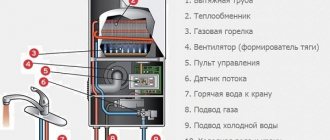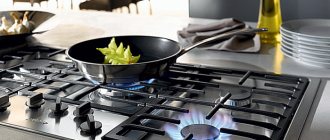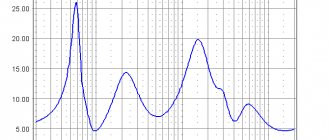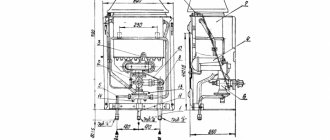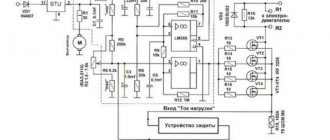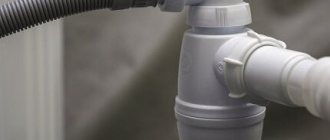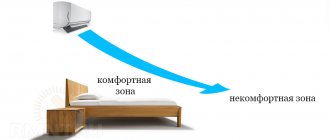Standards, rules and requirements
The operation of gas equipment in the home, due to the high risk of gas leakage and the associated dangerous consequences, must strictly comply with special requirements. In order to safely connect a gas water heater, you first need to take into account the following number of aspects:
- SNiP standards.
- Nuances of self-installation.
- Requirements for wall material.
- Chimney requirements.
Let's look at them in more detail.
SNiP standards
SNiP rules set the following series of requirements both for the equipment and for the room in which it will be installed:
- The volume of the installation room must be at least 7-8 m³.
- The minimum ceiling height is 200 cm.
- The diameter of the chimney channel for gas removal is at least 120 mm.
- It is prohibited to exhaust exhaust gases through the ventilation system.
- The gap between the upper edge of the device and the ceiling surface is from 250 mm.
- The height of the speaker from the floor when attached to the wall is at least 1 meter.
- The room with operating equipment must be naturally ventilated.
- The minimum horizontal distance to the hob is 40 cm. The column should not be located above a hot surface.
Layout of the gas water heater in the kitchen Source gorgazshop.ru
- The lowest operating pressure of the connected water supply is 0.1 atm.
- The wall material to which the equipment is mounted must not support combustion.
- The gas supply must be equipped with a shut-off valve located in close proximity to the unit.
The installation of a boiler room for a gas water-flow heater is permissible in any non-residential premises that meet the parameters of the above requirements. This may be a standard kitchen, but not a studio kitchen or living room, and not a toilet, bathroom or other similar room with constantly high air humidity.
Note! If the rules of the earlier edition allowed the installation of a geyser in a bathroom or toilet, then the new version excludes this possibility. However, if equipment that has been in use for a long time is simply replaced with a new one, then such installation is permitted and is not considered a violation of the law.
In the bathroom it is permissible to install only models that are protected from moist air Source mosoblgaz.ru
Nuances of self-installation
The installation of any gas equipment in the home must be carried out by specialized companies that have the appropriate approval to carry out this type of work. With a different installation method, the following number of problems are possible:
- Impossibility of warranty service. In the event of a breakdown or the need to carry out standard maintenance procedures, not a single specialized company will undertake maintenance without a note in the technical passport about the official installation of the equipment.
- Penalty for unauthorized installation. If representatives of Gorgaz check and discover the presence of unofficially installed equipment in the house, a mandatory fine and requirements for its dismantling or bringing it in accordance with the standards will follow.
- Carrying out mandatory registration procedures. If repairs, maintenance, replacement through service centers or simple connection to the gas mains are necessary, registration of the dispenser will still be required. However, it is easier and cheaper to do it at the installation stage, and not when it is already installed and in operation.
Installation and connection of the water heater should only be carried out by a specialist with permission Source cosmo-frost.ru
In addition, unauthorized installation of a gas water heater in a private house falls under the articles of the administrative code, as well as instructions for the use of gas equipment in everyday life:
- Art. 7.19 of the Code of Administrative Offenses of the Russian Federation - on unauthorized connection and use of gas appliances.
- Order of the VO "Rosstroygazifikatsiya" dated April 26, 1990 N 86-P - on the prohibition of the population from unauthorized gasification of homes, installation and maintenance of gas equipment.
Moreover, if unofficially installed devices lead to a fire or explosion, then the owner of the house will be responsible for damage to property, as well as to the health of others, within the framework of the criminal code.
See also: Catalog of companies that specialize in autonomous gasification of country houses and related work
Wall material requirements
A gas instantaneous water heater should be installed exclusively on a solid wall. At the same time, it must have a sufficient degree of fire resistance. The following materials are allowed:
- Concrete. The concrete-based wall meets the highest fire safety requirements.
- Brick. Meets high fire resistance standards. However, it is preferable to install the equipment on a wall made of solid blocks. For structures made from hollow analogues, it is necessary to use a reinforced fastening system. A similar requirement is also for cellular concrete.
The most reliable and safest way is to attach the column to a wall made of concrete or brick Source liquidsystems.ru
- Drywall. Non-flammable grade material must be used. In this case, a metal frame is used for reliable fixation.
- Tree. In a house with wooden walls, you can also install a geyser, but only on condition that the direct installation site is protected by a special coating of metal and asbestos with a thickness of at least 3 mm, or if a part of the wall is formed under the installation site from non-combustible materials - brick, concrete.
- Plastic panels. Direct installation of the device on an already installed finish is prohibited according to fire safety standards - due to the flammability of the material. However, it is possible to finish the wall with installed units, provided that the necessary gaps are observed to ensure ventilation.
Important! Installing a instantaneous gas water heater directly above the sink is prohibited by the new SNiP rules. This is primarily due to the fact that carbon monoxide is better able to accumulate and settle in damp air. Therefore, the minimum recommended gap of 0.4 m must be maintained to the sink.
The column should be located at some distance from the sink Source feko.com.ua
Chimney requirements
When installing a chimney for a flow-through gas water heater, the following requirements must be met:
- The removal of gaseous combustion products from the unit must occur through a separate pipe.
- The smoke exhaust system must function naturally - forced circulation is prohibited.
- The material of the smoke exhaust hose must withstand heating up to 2000C without deformation - mainly stainless steel.
- The chimney pipe must be rigidly mounted - without the slightest sagging.
- The channel width is set by the manufacturer and indicated in the technical documentation.
Fire safety standards when installing a chimney for a gas water heater also require the creation of fire-resistant gaps in the roof structure and horizontal ceilings when removing the pipe from the room. In this case, the outer parts must be insulated.
The chimney of a gas water heater must meet fire safety requirements Source oteple.com
Advantages and disadvantages of geysers
If we talk about which device to choose, first of all it should be noted: a gas heater requires a gas supply system
in a house or apartment. That is why devices are rarely installed in dachas.
The advantages of the unit include the following factors:
- Economical.
If buyers are interested in the question of what is more profitable, a water heater or a boiler, they should choose the gas option. - The gas appliance is quite compact.
- The main advantage of the column is its ability to instantly provide hot water in any volume.
- The speakers last much longer than eclectic devices and are easy to use.
There are also disadvantages:
- Difficult to install
. To do this, you not only need to call specialists and purchase metal pipes, but also collect the necessary package of documents. A ventilation system is required. - When using the column, no open flame is expected. Before attaching the equipment to the wall, it should be treated with a thick layer of insulating material.
- When using a heater, open water taps in the house affect the pressure in the tap.
Required Documentation
During the initial installation of a flow-through gas water heater, a number of approvals are carried out in various authorities on the following points:
- Obtaining consent for gas supply and installation of offtake from transporters and distributors.
- Perform consumption calculations, create a list of technical conditions.
- Drawing up a project. Agreements are concluded with the relevant authorities and documents for obtaining permits are collected.
- Upon completion of installation of the equipment, contracts are concluded with the city or regional gas service.
In this case, the following list of documents must be prepared:
- A copy of the document confirming the ownership of the house.
- Copy of passport – pages 2, 3 and 5.
- Copy of TIN.
- A copy of the technical passport of the unit.
- Document on concluding a contract for gas consumption.
- Gas installation maintenance agreement.
- A copy of the technical passport of the gas meter and a document on its regular inspection.
- Specifications for connection to the gas main and their confirmation.
- A copy of the project for gasification of the facility with a Gazprom metrology stamp.
Gas water heater in the interior of a modern kitchen Source cdnmyslo.ru
The collected documents are submitted to the appropriate authorities, upon completion of which verification the applicant receives a conclusion on permission and further actions.
Purchase of materials and installation of the column
Having received the project documentation in hand, you can begin preparing and purchasing consumables that will be used to install a geyser in the apartment and connect it to the water supply and gas. Let us give an approximate list of them with comments:
- connecting chimney pipe made of metal with a wall thickness of at least 1 mm, whose diameter is equal to or greater than the outlet pipe of the heater;
- pipes and fittings for water and gas supply. It is recommended to avoid connections with flexible hoses, which tend to break in the middle of the night due to increased pressure in the network. It is better to connect the geyser directly to the water supply using metal-plastic, PPR or polyethylene;
- shut-off valves for all 3 pipelines. Mesh filters for gas and water are needed if they are not available at the entrance to the house;
- fasteners for hanging the heater from the wall (if one is not included in the kit) and laying all pipes, including the chimney;
- If the speaker is installed on a wall made of combustible materials, you will have to purchase a sheet of galvanized steel or asbestos to lay between the device and the wall. The latter should protrude 100 mm beyond its dimensions.
Note. A detailed list of all necessary materials for connecting to the gas main must be included in the specification for the project.
When everything is ready, the unit can be hung from the wall, observing the standard distances to the nearest walls and objects. The figure below shows the installation diagram of the device indicating these distances:
As for the chimney pipe, in rooms with a height of up to 2.7 m it is necessary to maintain a length of the vertical section of 25 cm, over 2.7 m - 50 cm. The total length of the connecting pipe should not exceed 6 m with the number of turns no more than 3. The distance from the flue to fireproof walls and ceilings are at least 50 mm, and combustible - 250 mm. If this section of the wall is protected with iron or asbestos, the clearance can be reduced to 100 mm.
Installation stages
When the gas pipeline is connected, the technical conditions are met and permission is received, the direct installation of the equipment begins. However, in order to properly install a gas water heater in a private home, you must first prepare the place to meet the requirements. If the unit is simply replaced, then the old one is first dismantled, and, if necessary, the wall is repaired and the chimney and other components are updated.
The installation procedure is performed according to the following algorithm:
- The front panel is removed from the unit.
- Markings are made for mounting on the wall.
- Fixation points are checked at the building level.
- Holes of the required depth and diameter are drilled.
- Fastening elements are installed.
- A mounting plate or bracket is mounted - if they are included in the water heater kit.
- The unit itself is installed on the plate.
- The chimney pipe is connected and attached to the outlet in the wall.
Installation, connection, and configuration of the column must be performed by a qualified specialist Source tildacdn.com
The front panel is not installed, since the column must first be connected to the water and gas pipeline.
Speaker setup
When all possible work has been completed, all that remains is to connect the column to the gas pipe. We invite specialists from a licensed organization and provide them with a project and consumables. They install the gas line and pre-set the heater. More precisely, they check his safety equipment (automatic gas valve). All that remains is to make the first launch.
Important! Do not turn on the instantaneous heater or insert batteries into the socket while its heat exchanger is empty. You need to open both water taps, and then open hot water on any mixer. Wait for a steady stream of water and turn off the mixer.
Next, batteries are inserted into the automatic unit compartment and the gas valve is opened. If all the rules for installing a geyser are followed, then after opening the hot water, the device will start on its own. You only need to adjust the outlet water temperature, the recommended value is 50 ºС. A device with manual ignition will, accordingly, first have to be ignited using a button, and then turn on the water.
Video description
Video example of installing a gas water heater:
Next, a separate branch is laid from it to the unit. There are two possible ways to connect a gas water heater to a gas pipeline:
- Precise pipe delivery directly to the connection point. In this case, the device is first installed, and then a gas pipeline is connected to it. This eliminates the need for a flexible hose. The downside is complete dependence on the work schedule of specialists.
- The approximate pipe connection is 0.5 m before the installation site of the unit. It is permissible to first install the pipeline and then install the column more freely. In this case, for the final connection you will have to use a short flexible pipe. The method allows you to install equipment at any suitable time - regardless of the work hours of the craftsmen.
Upon completion of the procedure, the water heater is connected to a water source. For this purpose, a distributor tee is cut into the cold water supply, from which a separate pipe is led to the heat exchanger. Installation can be done in two ways:
- By bringing the pipe 0.3 m to the unit, and then connecting it with a flexible hose.
- Direct connection using copper, steel or metal-plastic pipes.
Connection diagram for a geyser to water and gas
If you are installing a column for the first time, you will have to run a gas pipe to it. To do this, you will need to invite craftsmen who will cut a tee into the gas pipe and install the pipe on it.
You can hang the pipe directly to the connection point. This gas connection scheme eliminates the need to use a gas hose. In this case, you must first install the column, and only then connect the gas pipe.
Experts recommend following the diagram for connecting the geyser to water and gas.
The other option is more practical, as it allows you to install the column at any time convenient for you. In this case, the pipe is led to the installation only half a meter, and the remaining route is installed by installing a gas valve.
Next, you need to connect the gas pipe to the water supply. This connection is best made using a movable union nut.
Ball valves are installed on cold and hot water lines. It is also advisable to install coarse and fine filters in front of the column. Such devices will allow you to increase the service life of the heat exchanger.
It is very important to find a high-quality speaker, since your safety will depend on how good the unit you choose is. We advise you to take a closer look at models from well-known manufacturers, for example, Bosch or Vaillant.
To connect water to the column, you can run a pipe 30 cm and finish the remaining distance with a flexible hose or connect pipes made of steel, metal-plastic or propylene directly to the column. To install the pipes, you will need to install a special tee into the water supply.
Setup and launch
Before starting any gas equipment, the integrity of the supply lines is first checked. These are primarily seams, joints and joints. The water pipeline should not leak, and the gas pipeline should not allow gas to pass through. If the malfunction of the first is immediately noticeable, then a special method must be used to check the second. Its essence is as follows:
- All inspection points are lubricated with soapy water.
- Next, the gas valve opens.
- A visual inspection of problem areas is carried out.
If soap bubbles appear and grow, it means that the connections are not tight and require replacement or repair.
When the leak test is completed and the detected faults are eliminated, the gas water heater is configured. The procedure is carried out strictly according to the instructions by the masters. They must carry out the first startup and balance the pressure in the system using a pressure gauge.
Starting and setting up a gas water heater
Before starting the column, it is necessary to check all the seams connecting to the water supply and gas pipeline hoses. They must be sealed. There is a proven method by which you can check the tightness of gas connections.
How to check the tightness of gas connections:
- Lubricate all gas pipe joints and fittings with soapy water;
- Open the gas valve;
- Check connections for bubbles.
If there are no bubbles, then the connections are sealed. You can check the connections to the water supply without any special accessories, just by making sure the seams are dry.
Next, you need to perform all the necessary steps to start the column according to the instructions. A very important step is setup. It can only be done with a pressure gauge. The adjusting bolt sets the gas pressure, and the wiper sets the air supply.
Briefly about the main thing
Installation, connection and operation of a gas instantaneous water heater in a private house is allowed when considering the following number of aspects:
- SNiP standards.
- Requirements for the material of the surface on which the column will be mounted.
- Requirements for the smoke exhaust system.
- Features of self-installation, and what problems it is associated with.
During the initial installation of a geyser, it is necessary to collect a number of important documents, conclude contracts, obtain consent and permits from special services. The procedure for installing the unit, connecting gas and water to it, as well as further setup and first start-up is carried out strictly according to the instructions by professional specialists with the appropriate approval.
Ratings 0
How to install a geyser
We have come directly to the stage of installing the gas water heater. If you have installed gas lines, received all the necessary documentation and completed all the specifications, then it will not be difficult to install it yourself.
How to install the column correctly:
- The front panel is removed from the column. Using the markings for the speaker mounts, mark the installation locations for the anchors. The correctness of the markings is checked using a building level. Now, according to the markings, you need to drill holes, insert dowels and anchors.
- Most modern speakers have a special mounting plate. It must be installed at the marked level, leveled using a building level.
- Install the column itself onto the plate. Clicks indicate correct installation.
- Lay a corrugated pipe from the outlet of the column to the common chimney. Treat the wall with a hammer drill and insert a chimney. The gap between the wall and the chimney needs to be foamed.
It's too early to install the front panel. First you need to connect to gas and water.
General installation requirements
You can install a gas water heater in an apartment only if the room allocated for the boiler room (the kitchen most often plays this role) meets the following requirements:
The height of the shelf is from 200 cm. Almost all modern apartments satisfy this condition. If you did not lower the ceiling in your kitchen using multi-tiered plasterboard structures, then this limitation most likely will not affect you.
The boiler room area is at least 8 m2. Moreover, the distance from the supporting surface (on which the column will be mounted) to the opposite wall must be at least 100 cm. Owners of small apartments may have difficulties with this point. Gas-consuming appliances cannot be installed in rooms with insufficient dimensions.
The area of the window in the kitchen, or rather the glazing of the opening (excluding the frame), cannot be less than 3% of the volume of the room. For example, for a boiler room with a minimum permissible area and ceiling height, the window glazing area cannot be less than 0.48 m2 (2 × 8 × 0.03).
The window must open
The window should open. Without fail. This will help organize emergency ventilation of the boiler room. In addition, a separate ventilation duct with a diameter of 13-15 cm is installed in the room.
The distance to the valve cannot be more than 2-2.2 meters, since the maximum length of the hose with which the gas water heater is connected is 2.5 m, and it must hang freely.
The width of the doorway leading to the boiler room (kitchen) cannot be less than 80 cm, with a gap of 20 mm between the door leaf and the floor. This limitation is due to the need to ensure ventilation of the room and the flow of oxygen into the combustion chamber area of the column.
But the requirements for the mandatory presence of a chimney in the house can be circumvented by choosing a model of a boiler with forced exhaust, designed in the form of a coaxial air duct (like parapet gas boilers).
Documents for installing a geyser
Natural gas is a highly efficient coolant and gas supply is a form of energy supply. Our country has the largest reserves of natural gas. Therefore, the use of gas for heating has become very widespread in Russia. Considering the spread of shale gas production technology, we can predict the widespread use of gas-using equipment everywhere.
The basic legal economic and organizational foundations of relations in the field of gas supply in the Russian Federation are determined by the Federal Law “On Gas Supply in the Russian Federation” dated March 31, 1999 No. 99-FZ, which is based on the provisions of the Constitution of the Russian Federation and the Civil Code of the Russian Federation. The safe operation of equipment and gas supply systems is regulated by departmental regulations.
A gas water heater connected to a gas supply source is part of the gas utility system. The gas industry is a complex technological complex of gas distribution and gas consumption systems designed to provide consumers with natural and liquefied hydrocarbon gases.
To ensure the safe operation of gas supply systems, special agencies, services, sections and other divisions are created that organize and carry out work on the technical operation of gas distribution system facilities. Therefore, the process of connecting a simple geyser to the gas supply system is not simple.
When considering the process of installing a geyser, it is necessary to highlight three possible cases. The first case is when the installation of the geyser will be carried out in the same place, the second case,? when the geyser is installed in a new place, the third case is when the geyser is installed for the first time.
What to do in these cases? If the installation of the geyser is carried out in the same place, there should be no problems. The main requirement: the column must be certified and must be approved for installation by regulatory authorities.
Before starting work, you need to contact the Housing Office to provide certified copies of plans and diagrams for the installation of gas supply, water supply, and smoke removal systems (the gas supply system plan must indicate the location of the gas water heater and its technical parameters). After receiving the above information, you must write an application to the city gas service with a request to allow the replacement of the dispenser, subject to maintaining the previous location of its installation, as well as an application for repair/replacement of gas and water mains in this area. The city gas service will carry out this work, after completion of which you will receive a signed Commissioning Certificate and a dispenser installed in accordance with regulatory requirements.
If the installation of a geyser will be carried out in a new location, then such installation involves changing the supply gas and water supply routes, as well as changing the smoke exhaust system. You need to start by obtaining a report on the technical condition of the chimney from the fire inspectorate. Next you need to: order and receive a project for moving the gas water heater (usually the city gas service takes on the design). If the building is an apartment building, obtain permission from the city administration to renovate the apartment.
With the received documents, gas water heater passport, title documents for housing, submit an application to the gas service. Representatives of the gas service will carry out work on installing the column and connecting it to the gas supply and water supply.
When the work is completed, a specialist from the regional gas operating service will set up and start the column. After this, you can seal the gas meter, receive Certificates of Conformity of the installed equipment from the fire inspection, technical supervision, and receive a Commissioning Certificate. In addition, information about the transfer of the gas water heater must be submitted to the BTI.
If the geyser is being installed for the first time, in this case it is necessary to first build a gas supply line. This is an expensive and time-consuming process for designing gas transmission and distribution networks. The construction of trunk networks is beyond the capabilities of private developers; local governments are engaged in this task. The construction of distribution networks can be carried out by pooling. In general, the scheme of actions is as follows: obtaining initial permits, design and construction.
Obtaining initial permitting documents includes: obtaining consent for gas supply to the facility from gas distribution and gas transportation organizations, calculating the need for natural gas, with significant volumes of consumption, obtaining consent from Mostransgaz and Gazprom, obtaining technical specifications from gas transportation and gas distribution organizations, resolving the issue of land allocation for gas pipeline Design includes: concluding a design contract, execution of design documentation and its examination, approvals. Construction includes: execution of construction and installation works, commissioning of a completed facility.
After this, you must contact the gas distribution organization to conclude a gas supply agreement.
The list of documents that must be provided depending on the region may be approximately as follows:
- Letter of agreement;
- Completed Gas Buyer's Passport;
- A copy of pages 2, 3, 5 of the citizen’s personal passport;
- A copy of the certificate of registration with the tax authority (TIN);
- A copy of the certificate of state registration of the right to the property (at the location of the gas-using equipment) or other document of title to the gasified building;
- Technical conditions for connection to the gas transportation and gas distribution system, issued respectively by the gas transportation or gas distribution organization;
- Documents confirming the buyer's fulfillment of the technical conditions for connecting gas-using equipment to the gas distribution system (copy of the Acceptance Certificate for the completed construction of the gas distribution system facility, etc.);
- List and technical characteristics of installed gas-using equipment for each facility (type, type, quantity), documents confirming the composition and type of gas-using equipment, and compliance of this equipment with the technical requirements established for it (copy of the passport of gas-using equipment - pages with name, type, power ( kW)/gas consumption, (m3/h)) indicating the gas consumption metering unit;
- A copy of the Act on the delimitation of the balance sheet ownership of gas networks and the operational responsibilities of the parties (on determining the boundaries of the division of property), drawn up with the gas distribution organization;
- Copies of passports for a gas meter, corrector-calculator, pressure, differential pressure and temperature sensors with valid verification or verification certificates, a copy of the measurement procedure verification report or certificate of certification of the measurement technique;
- Confirmation of the gas supplier's approval of the consumer's choice of measuring instruments for the gas flow metering unit at the design stage (copy of a page from the gasification project with the stamp of the metrology department of Gazprom Mezhregiongaz LLC);
- License to operate an explosion- and fire-hazardous production facility (maintenance agreement).
- Formalized consent of the person to the processing of personal data.
It is prohibited to replace the column with your own hands.
It is important to remember that the choice of location for installing the column should be based on the possibility of arranging the hood in accordance with all rules and regulations, the convenience of the location of the column, as well as the possibility of supplying communications. The volume of the room in which the speaker will be installed must be from 8 m2, however, the Rules prohibit installing a speaker in the bathroom, because this room does not meet the basic requirements (see SNiP 2.04.08-87 GAS SUPPLY). Speakers are installed only on fireproof walls.
In another case, the fire-resistant surface is lined with a galvanized sheet from 0.8 to 1 mm thick, having previously secured a sheet of basalt heat-insulating cardboard from 3 to 5 mm thick to the wall. It is prohibited to use a corrugated aluminum ventilation pipe to install a chimney! The standards for installing the column, prescribed in GSN V.2.5-20-2001, for the implementation of a chimney, prescribe the use exclusively of pipes made of stainless or galvanized steel. In this case, the thickness of the pipe must be at least 1 mm. Any decorative panels that many tenants use to cover gas equipment must be easily removable, i.e. — nothing should interfere with access to the column, and panels or decorative boxes should be made exclusively from non-combustible materials (see SP 41-108-2004).
The gas supply shut-off valve installed on a new gas water heater must be mounted near the water heater and have a yellow handle (see SNiP 2.04.08-87). The standards for installing the connection between the column and the water supply system provide for the use of metal pipes or flexible hoses with an internal diameter of at least 13 mm. In this case, the length of the hose or pipe must be no more than 2.5 m (similar parameters must be observed when arranging a connection to the gas supply system).
Installation of a gas connection to a water column should only be carried out with a shut-off valve installed. Before installing the chimney, check the draft. Under normal conditions, it should be approximately 1.96-29.40 Pa (depending on the type of room). The gas exhaust pipe must have at least 110 mm in diameter, while its length cannot exceed 2 m, but cannot be less than 300 mm. The slope of the gas exhaust pipe must be at least 2° upward.
